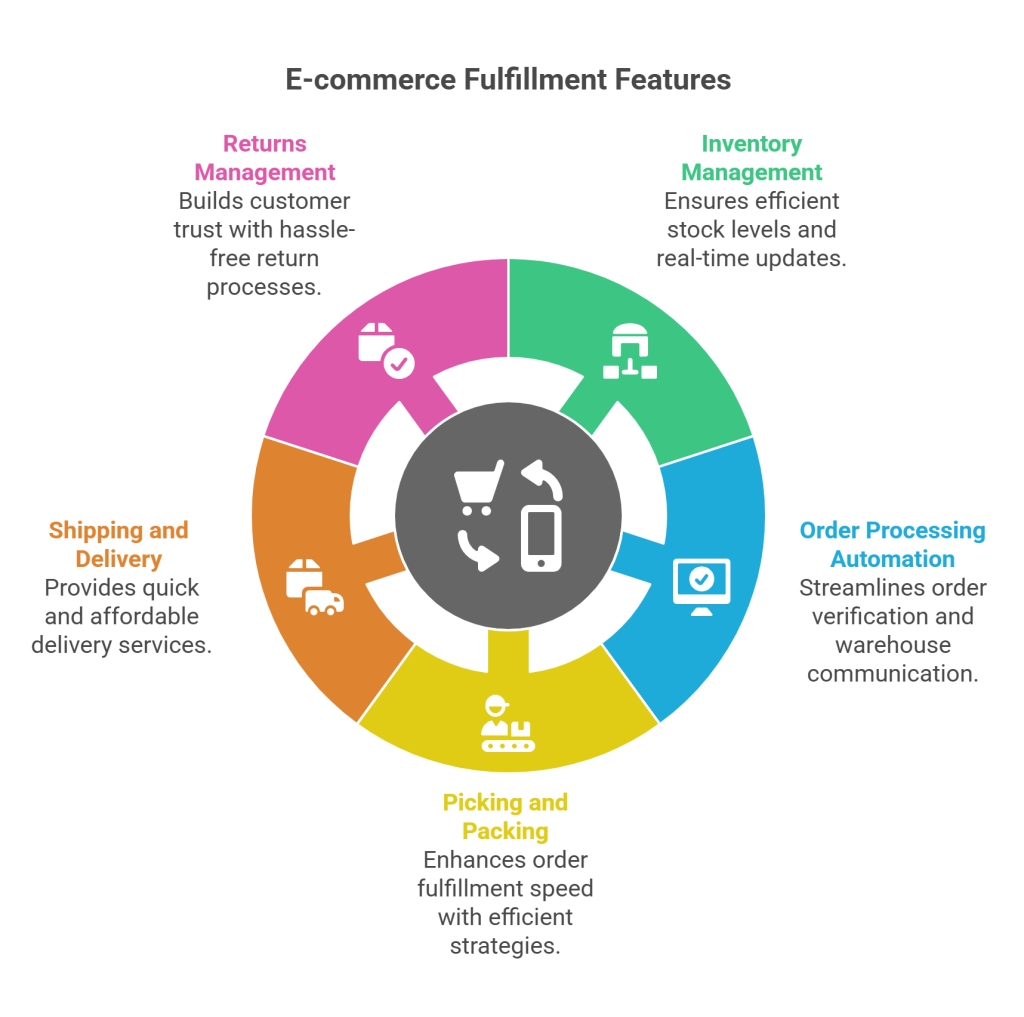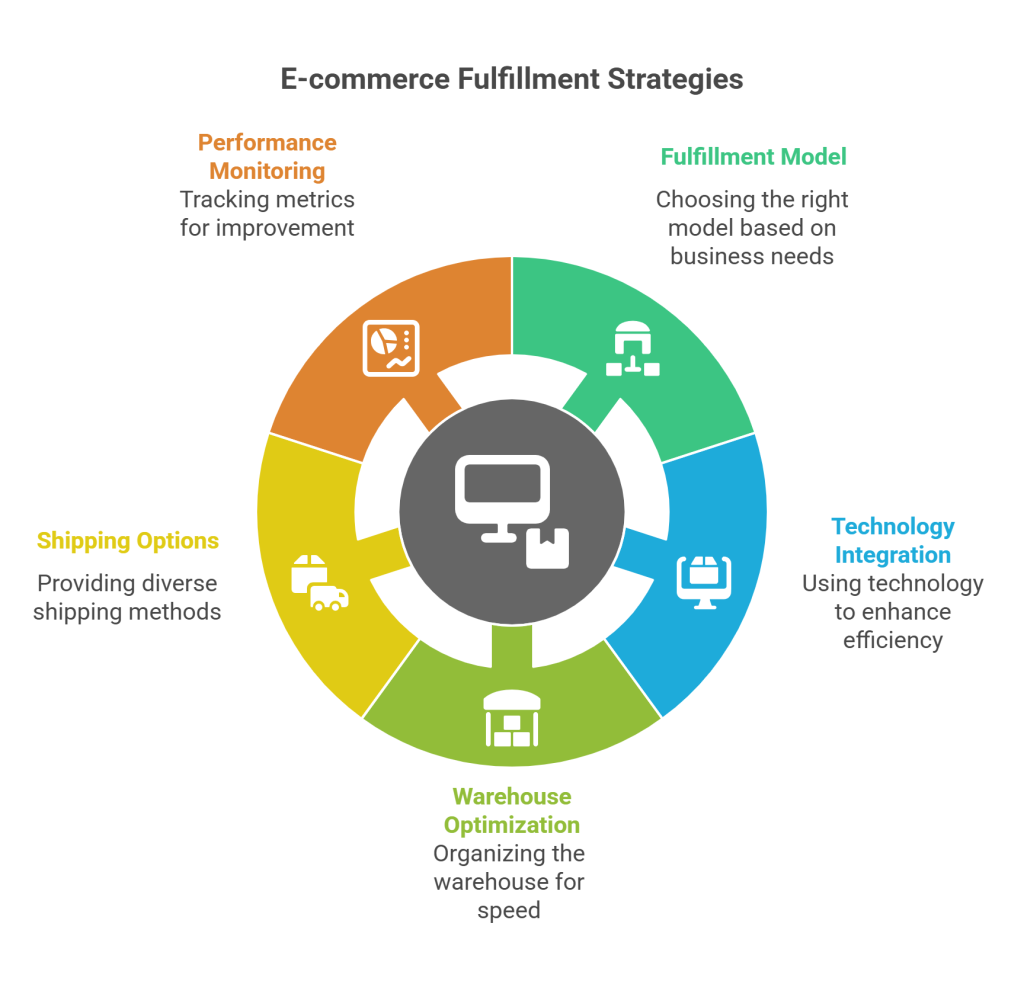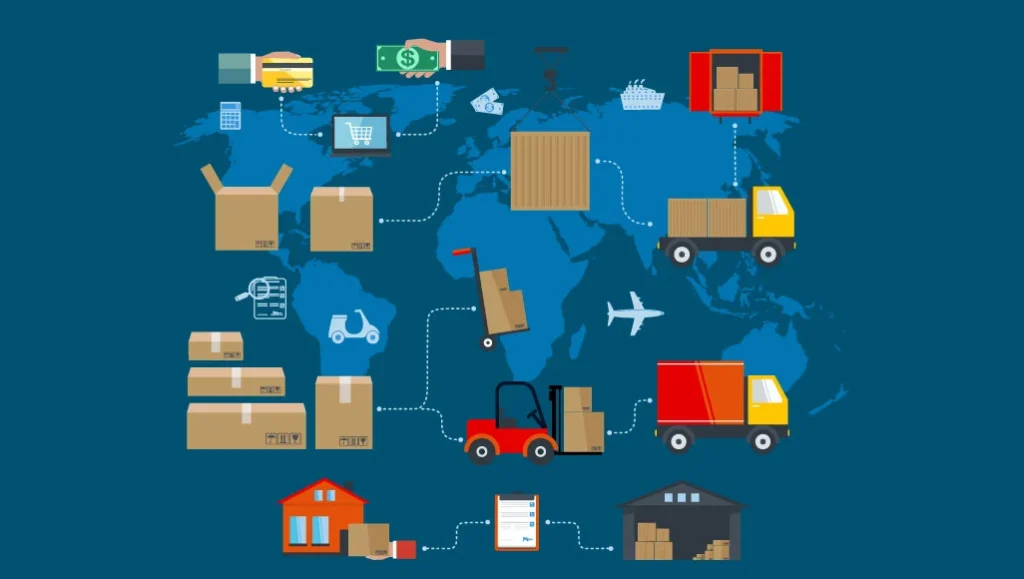E-commerce has revolutionised the way businesses operate, with fulfilment playing a crucial role in ensuring seamless delivery to customers. Whether you run a small online store or a large e-commerce enterprise, understanding e-commerce fulfilment is vital for optimising operations, improving customer satisfaction, and scaling your business.
In this blog, we will explore the definition of online fulfilment, its key features, benefits, and best practices to help you streamline your online retail operations.
What is E-commerce Fulfilment?
The E-commerce fulfilment process includes receiving, processing, packing, and shipping customer orders placed through an online store. It encompasses inventory management, warehousing, order processing, picking and packing, shipping, and handling returns.
This process is the backbone of online retail, ensuring that customers receive their products accurately and on time. Businesses can either handle fulfilment in-house, outsource to third-party logistics (3PL) providers, or use dropshipping models to streamline the process.
Key Features of E-commerce Fulfilment Services

1. Inventory Management
Proper inventory management ensures that stock levels are maintained efficiently, preventing issues such as overselling or stockouts. Advanced order fulfilment systems integrate with online stores to provide real-time inventory updates.
2. Order Processing Automation
Modern ecommerce fulfillment solutions leverage automation to streamline order processing. Once a customer places an order, the system automatically verifies payment, updates inventory, and forwards order details to the warehouse for picking and packing.
3. Picking and Packing
This is the core of ecommerce fulfillment, where warehouse staff pick items from storage and pack them securely. Efficient picking strategies such as batch picking, wave picking, or zone picking can significantly enhance order fulfilment speed.
4. Shipping and Last-Mile Delivery
Shipping involves selecting the best courier services, printing shipping labels, and tracking deliveries. A robust ecommerce fulfillment process ensures that customers receive their orders quickly and affordably, enhancing their shopping experience.
5. Returns Management
An efficient returns management system is a crucial part of ecommerce fulfillment. A hassle-free return process builds customer trust and increases retention. Businesses should provide clear return policies and a streamlined process for handling returned products.
Benefits of a Strong Commercial Fulfilment Strategy
A well-structured fulfilment strategy can provide several advantages, including:
1. Faster Order Processing
A streamlined e-commerce fulfilment system costs reduce order processing time, ensuring quick deliveries and higher customer satisfaction.
2. Reduced Shipping Costs
By optimizing logistics and warehouse locations, businesses can lower shipping costs and offer competitive pricing to customers.
3. Improved Customer Experience
Timely deliveries, real-time tracking, and seamless return policies contribute to a positive customer experience, increasing brand loyalty.
4. Scalability and Business Growth
A reliable ecommerce fulfillment process allows businesses to scale effortlessly by managing increased order volumes efficiently.
5. Error Reduction
Automating order fulfilment reduces the chances of human error in order processing, packaging, and shipping.
Types of E-commerce Fulfilment
1. In-House Fulfillment
This model involves managing Ecommerce order fulfilment solutions internally by storing inventory, processing orders, and shipping products directly to customers. It is ideal for small businesses with manageable order volumes.
2. Third-Party Fulfillment (3PL)
Businesses can outsource fulfilment to third-party logistics (3PL) providers who handle warehousing, packing, and shipping. This option is beneficial for businesses experiencing rapid growth and high order volumes.
3. Dropshipping
In this model, businesses do not hold inventory. Instead, when an order is placed, the supplier ships the product directly to the customer. Dropshipping reduces upfront costs but offers less control over inventory and shipping.
Best Practices for Optimizing E-commerce Fulfilment

1. Choose the Right Fulfillment Model
Select a fulfilment model based on your business size, budget, and scalability needs. Small businesses may prefer in-house fulfilment, while larger enterprises can benefit from 3PL services.
2. Leverage Technology
Use warehouse management systems (WMS) and automation tools to improve inventory tracking, order accuracy, and efficiency.
3. Optimize Warehouse Layout
A well-organized warehouse with clearly labelled sections and optimized picking routes can enhance fulfilment speed.
4. Offer Multiple Shipping Options
Providing different shipping methods, including standard, express, and same-day delivery, can cater to diverse customer preferences.
5. Monitor Performance Metrics
Tracking key fulfilment metrics such as order accuracy, shipping time, and return rates can help identify areas for improvement.
The Future of E-commerce Fulfilment
E-commerce fulfilment challenges remain but the landscape is evolving rapidly, with technological advancements shaping the future of order processing and delivery. Here are some emerging trends:
1. AI and Machine Learning
AI-powered demand forecasting helps businesses optimise inventory levels and reduce stockouts. Machine learning algorithms also improve warehouse efficiency and automate picking processes.
2. Robotics and Automation
Warehouse automation, including robotic picking and packing systems, enhances speed and accuracy in ecommerce fulfillment.
3. Sustainable Fulfillment
Eco-friendly packaging, carbon-neutral shipping, and sustainable logistics practices are becoming a priority for many e-commerce brands.
4. Same-Day and Drone Delivery
Retail giants are experimenting with same-day deliveries and drone shipping to reduce delivery times and enhance customer satisfaction.
Conclusion
E-commerce fulfilment is the backbone of retail operations. By understanding its features, benefits, and best practices, businesses can optimize their fulfilment process, enhance customer satisfaction, and scale their operations efficiently. Whether you choose in-house fulfilment, 3PL services, or drop shipping, adopting the right strategies and technologies will help you stay competitive in the fast-evolving e-commerce landscape.
If you want to streamline your logistics strategy, consult an expert like Qodenext to ensure seamless supply chain traceability and tracking.
FAQs – E-commerce Fulfilment
1. What is the difference between online fulfilment and dropshipping?
Ecommerce fulfilment involves storing, packing, and shipping inventory to customers, while drop shipping relies on suppliers to ship products directly to customers without holding inventory.
2. How can I improve my e-commerce fulfilment outsourcing?
You can optimize your ecommerce fulfillment outsourcing by using automation, selecting the right 3PL model, optimizing warehouse layouts, and monitoring key performance metrics.
3. What does e-fulfilment mean?
Online fulfilment is the process of delivering online orders from handling customer queries to inventory distribution.
4. How does inventory management impact fulfilment?
Efficient inventory management prevents stockouts and overstocking, ensuring accurate order fulfilment and better customer satisfaction.
5. What role does automation play in stock fulfilment?
Automation improves order processing speed, enhances picking accuracy, and reduces human errors, leading to faster and more efficient fulfilment operations.
6. How does fulfilment impact customer experience?
A seamless ecommerce fulfillment process ensures timely deliveries, real-time tracking, and hassle-free returns, all of which contribute to a positive shopping experience and customer loyalty.
7. What are the common challenges in order fulfilment?
Some challenges include inventory mismanagement, high shipping costs, order errors, delayed deliveries, and returns management. Businesses can overcome these with automation and strategic logistics planning.





